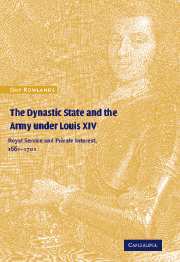Book contents
- Frontmatter
- Contents
- List of maps
- Acknowledgements
- List of abbreviations
- Family tree of the Le Tellier: 1. Principal branch
- Family tree of the Le Tellier: 2. Royal household marital connections
- Map 1 The French provinces under Louis XIV
- General introduction: ‘Absolute monarchy’, dynasticism and the standing army
- Part I ‘Patrimonial bureaucracy’: The Le Tellier dynasty and the Ministry of War
- Part II The forging of the French officer corps and the standing army under Louis XIV
- Part III The high command of the French armies
- Introduction
- 9 The commanders-in-chief and the delegation of royal authority
- 10 The appointment of general officers
- 11 The summits of ambition and the rewards of good service: the bienfaits du roi and the high command
- Conclusion: The preservation of the dynasty
- Appendix 1 Defining the grands
- Appendix 2 The proportion of revenue generated by the Extraordinaire des Guerres as a ‘primary receiver’
- Bibliography
- Index
- CAMBRIDGE STUDIES IN EARLY MODERN HISTORY
Introduction
Published online by Cambridge University Press: 20 May 2010
- Frontmatter
- Contents
- List of maps
- Acknowledgements
- List of abbreviations
- Family tree of the Le Tellier: 1. Principal branch
- Family tree of the Le Tellier: 2. Royal household marital connections
- Map 1 The French provinces under Louis XIV
- General introduction: ‘Absolute monarchy’, dynasticism and the standing army
- Part I ‘Patrimonial bureaucracy’: The Le Tellier dynasty and the Ministry of War
- Part II The forging of the French officer corps and the standing army under Louis XIV
- Part III The high command of the French armies
- Introduction
- 9 The commanders-in-chief and the delegation of royal authority
- 10 The appointment of general officers
- 11 The summits of ambition and the rewards of good service: the bienfaits du roi and the high command
- Conclusion: The preservation of the dynasty
- Appendix 1 Defining the grands
- Appendix 2 The proportion of revenue generated by the Extraordinaire des Guerres as a ‘primary receiver’
- Bibliography
- Index
- CAMBRIDGE STUDIES IN EARLY MODERN HISTORY
Summary
The aggressive foreign policy pursued by Louis XIV in the first half of his ‘personal rule’, and the ensuing suspicion this engendered, which in turn provoked the two greatest conflicts of his reign – the Nine Years War and the War of the Spanish Succession – required the French king to maintain a large standing army during peacetime and to put even larger forces into the field on what appeared to be an ever-increasing number of geographical fronts during open hostilities. The over-arching presence of war throughout Louis's reign had significant effects upon the French army and its relationship with the wider society, especially the social elites. Part I of this book has considered the changes which affected the Le Tellier dynasty and the civilian administration of the army, while part II examined the regimental officer corps to explain the way Louis XIV and his advisers reshaped the standing army to make it a more reliable and responsive force for the waging of war and the deterrence of foreign threats.
- Type
- Chapter
- Information
- The Dynastic State and the Army under Louis XIVRoyal Service and Private Interest 1661–1701, pp. 269 - 274Publisher: Cambridge University PressPrint publication year: 2002

